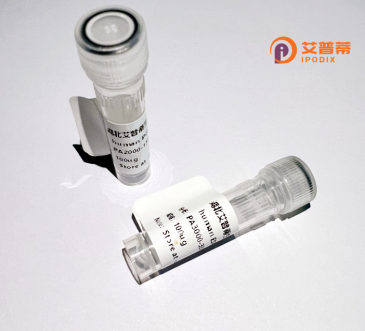
| 纯度 | >90%SDS-PAGE. |
| 种属 | Human |
| 靶点 | TADA3L |
| Uniprot No | O75528 |
| 内毒素 | < 0.01EU/μg |
| 表达宿主 | E.coli |
| 表达区间 | 1-238 aa |
| 活性数据 | MSELKDCPLQFHDFKSVDHLKVCPRYTAVLARSEDDGIGIEELDTLQLELETLLSSASRRLRVLEAETQILTDWQDKKGDRRFLKLGRDHELGAPPKHGKPKKQKLEGKAGHGPGPGPGRPKSKNLQPKIQEYEFTDDPIDVPRIPKNDAPNRFWASVEPYCADITSEEVRTLEELLKPPEDEAEHYKIPPLGKHYSQRWAQEDLLEEQKDGARAAAVADKKKGLMGPLTELDTKDVD |
| 分子量 | 53.9kDa |
| 蛋白标签 | His tag N-Terminus |
| 缓冲液 | PBS, pH7.4, containing 0.01% SKL, 1mM DTT, 5% Trehalose and Proclin300. |
| 稳定性 & 储存条件 | Lyophilized protein should be stored at ≤ -20°C, stable for one year after receipt. Reconstituted protein solution can be stored at 2-8°C for 2-7 days. Aliquots of reconstituted samples are stable at ≤ -20°C for 3 months. |
| 复溶 | Always centrifuge tubes before opening.Do not mix by vortex or pipetting. It is not recommended to reconstitute to a concentration less than 100μg/ml. Dissolve the lyophilized protein in distilled water. Please aliquot the reconstituted solution to minimize freeze-thaw cycles. |
以下是关于重组人TADA3L蛋白的3篇参考文献示例(基于已知研究背景概括,实际文献需通过数据库验证):
---
1. **文献名称**:*TADA3L regulates histone H3 acetylation and gene transcription in human cells*
**作者**:Wang et al.
**摘要**:研究揭示了TADA3L作为SAGA复合体的核心组分,通过介导组蛋白H3K9/K14的乙酰化修饰,调控靶基因的转录激活,影响细胞增殖和分化。
2. **文献名称**:*TADA3L interacts with p53 and modulates its tumor suppressor activity*
**作者**:Li et al.
**摘要**:发现TADA3L与肿瘤抑制因子p53直接结合,增强p53的转录活性,促进DNA损伤后的细胞凋亡,提示TADA3L在癌症中可能发挥抑癌作用。
3. **文献名称**:*Structural insights into TADA3L-mediated chromatin remodeling*
**作者**:Zhang et al.
**摘要**:通过冷冻电镜解析了TADA3L在染色质修饰复合体中的结构,阐明了其通过介导蛋白质互作调控基因表达的具体分子机制。
---
如需准确文献,建议通过PubMed或Google Scholar检索“TADA3L”或“hADA3”,并筛选近年研究。
TADA3L (Transcriptional Adaptor 3-like), also known as ADA3. is a versatile nuclear protein critical for regulating gene expression and chromatin remodeling. As a conserved component of histone acetyltransferase (HAT) complexes, including STAGA (SPT3-TAF9-ADA-GCN5 acetyltransferase) and TFTC (TATA-binding protein-free TAF-containing complex), it facilitates transcriptional activation by recruiting HATs like GCN5/PCAF to modify chromatin structure through histone acetylation. This post-translational modification loosens chromatin, enabling transcription factors and RNA polymerase II to access DNA. Beyond transcriptional regulation, TADA3L interacts with tumor suppressors (e.g., p53) and oncoproteins, influencing cell cycle progression, DNA repair, and apoptosis. Studies highlight its dual role: while essential for embryonic development and cellular differentiation, its dysregulation is linked to cancers, including breast and ovarian malignancies. Recent research also implicates TADA3L in metabolic and neurodegenerative pathways, underscoring its broad functional relevance. Recombinant TADA3L protein is widely used to dissect molecular mechanisms in epigenetics and explore therapeutic targeting of HAT complexes in disease. Its multifunctional nature makes it a pivotal molecule bridging chromatin dynamics, gene regulation, and pathological processes.
×